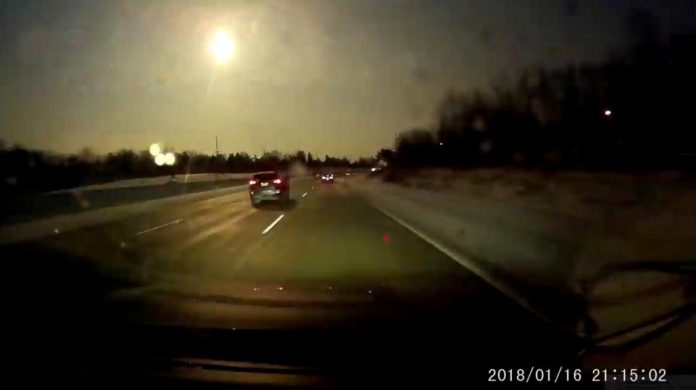Finding remnants of the meteor that flew over southeast Michigan on Tuesday is really shooting for the stars, experts say.
First, you’ve got to find a piece. Then you’ll need a studied eye to detect the difference between space rock and plain old pieces of Earth, they say.
There’s also the “first rule” of meteor hunting: “Never go on someone else’s property without asking for permission,” said Bill Cooke, lead of NASA’s Meteoroid Environment Office at the Marshall Space Flight Center in Huntsville, Alabama. Federal law says meteorites belong to the owners of the property on which they fall.
But that’s getting ahead of things since meteor hunters are looking for an object that has burst apart in its estimated 40,000 to 50,000 mile path to Earth.
“It exploded, and the object itself didn’t hit,” said Michael Narlock, head of astronomy at the Cranbrook Institute of Science in Bloomfield Hills. “So we’re talking about finding the debris field, and that’s hard to determine. There’s still some debate about what path it took.”
The bright, flashing light from the meteoroid — about the size of a cargo van, Narlock says — entering the atmosphere over the region Tuesday night could be seen as far away as New York City and parts of Canada. A loud boom was heard across Michigan, according to social media and people who recounted the experience.
NASA confirmed its meteor camera spotted the event at about 8:08 p.m. at Oberlin College in Ohio.
On Wednesday, the NASA Meteor Watch Facebook page said the meteoroid traveled northwest from the Brighton area to the Howell area .
“ … We have calculated that this was a very slow moving meteor — speed of about 28,000 miles per hour,” said the 1 a.m. post, citing the American Meteor Society . “This fact, combined with the brightness of the meteor (which suggests a fairly big space rock at least a yard across), shows that the object penetrated deep into the atmosphere before it broke apart (which produced the sounds heard by many observers).”
The post suggested that there were meteorites on the ground. That nugget reportedly sent meteor hunters scurrying in a field in Macomb Township on Wednesday after the U.S. Geological Survey put the epicenter of the explosion near 25 Mile and Card Road. Later Wednesday, NASA changed the location to somewhere north of Chelsea between Ann Arbor and East Lansing, Narlock said.
“We’re still piecing together the forensics about exactly what this was, even though there was video surveillance and tens of thousands of people saw it,” Narlock said. “We’re still trying to figure out what happened.”
The noise that followed the meteoroid entering the atmosphere could have been caused either by the explosion or a sonic boom, he said.
Dawn Elkins of St. Clair Shores said she saw the flash of light from inside her house. At the time, she had a migraine and assumed it was causing the lights to appear brighter. Then her husband told her it was a meteor.
“ I didn’t put two and two together until later on,” she said.
NASA defines “shooting stars” as bits of interplanetary material falling through Earth’s atmosphere and heated to incandescence by friction. They’re called meteoroids while hurtling through space, then become meteors for the few seconds they streak across the sky and create glowing trails, according to the agency.
The Earth periodically encounters a few small asteroids or large meteoroids, Cooke said, “and when they hit the atmosphere, they create these very bright fireballs.”
It’s rare to see a meteoroid over Michigan, he said. But elsewhere on the planet, “they happen a few times every month.”
If Tuesday’s space rock deposits ever are found and analyzed by NASA, the agency will name Michigan’s meteorite.
“Tradition holds that we give it the name of the town closest to where it was found,” Cooke said.
Space rock stalkers should look for debris that looks like pieces of charcoal and are heavy for their size. They would also be magnetic.
“If you stick a magnet to it, there will be some attraction,” he said. “Those are three guidelines. But there are Earth rocks that match those descriptions, too, so you have to be careful. The only way to tell for sure is to have it analyzed in a lab.”
The dark-colored chunks of rock will be smooth and may have a little pitting on them, says Cranbrook’s Narlock. They probably don’t have a lot of metal in them, so a metal detector won’t be much help, he said.
“It’s just going to be a challenge,” Narlock said. “The ground is covered in snow, and chances are, any chunks got covered by snow. But if you’re lucky, they hit in an area that’s easy to access in an open field.”
Still, even if someone finds some space dust, it doesn’t mean it will be valuable. Earthling economics holds sway and the price of the rock depends on the find and the buyer. At the least, NASA would be eager to study the type of meteorite, though the process could take months before you get your rock back, Cooke said, because few labs are equipped to test space material.
A meteorite’s value also depends on its type, something that can’t be determined until it’s analyzed. If it’s from the moon or Mars, you’ve struck pay dirt.
“ But those are exceedingly rare, and I doubt this one is from the moon or Mars,” Cooke said.















